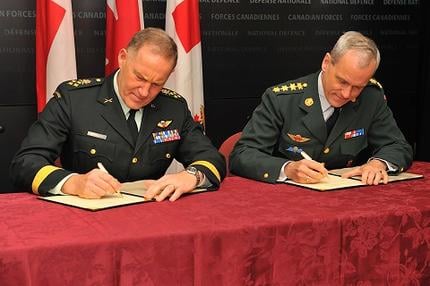
(L-R) Gen. Natynczyk, Canadian Chief of the Defence Staff and Gen. Bartels, Chief of Defence of Denmark sign the MOU. © Corporal Tanya Tobin, CFSU(O) Photo Services.
Just a few years ago, newspapers were full of reports stating that tensions between Canada and Denmark were aboil due to a dispute dating back to 1973 over tiny Hans Island, a rocky outcropping in the Nares Strait between Canada and Greenland. Today, both countries still claim possession of the barren island, yet they’ve been able to overlook their disagreement to sign a Memorandum of Understanding (MOU) on Arctic Defense, Security, and Operational Cooperation. This agreement fits in with Canada and Denmark’s attempts to ramp up diplomatic, military, and scientific cooperation as a way to defuse hostility.
General Knud Bartels, Danish Chief of Defense, and General Walt Natynczyk, the Canadian Chief of the Defense Staff, met in Ottawa May 13-14 to discuss NATO, the Arctic, Afghanistan, and counter-piracy. Thanks to the signing of the MOU, the two countries will now be able to facilitate cooperation in their Arctic regions through enhanced communication and information exchange, joint exercises, and visits.
The MOU builds on several recent visible efforts between the two countries to work together. In 2006, Canada and Denmark began carrying out a mapping mission of the Arctic. The final data, which has been gathered by drilling holes in the seabed and collecting aerial imagery, will be used in their final submissions of territorial claims to the United Nations Commission on the Limits of the Continental Shelf. Although Canada and Denmark’s claims overlap, as they both believe parts of the Lomonosov Ridge lying under the Arctic Ocean constitutes part of their landmasses, they are united in their belief that the Russians, who also claim the ridge, do not own it.
Then, in March 2010, the two countries engaged in joint military exercises as part of Operation Nunalivut, which were the first of its kind. 180 Canadian Rangers testing the tracking capability of GPS units in the Arctic were joined by Denmarks two military dog-sled patrol teams, called SIRIUS. Differences in the two countries’ methods of securing sovereignty over their Arctic lands became apparent through the Canadian’s approach of sending sheer manpower and resources up to the High North three times a year as part of their sovereignty operations, while the Danes just patrol 160,000 square kilometers of land in Northern Greenland with their dog-sled teams. The Danish way is definitely a lot cheaper. Danish Rear Admiral Henrik Kudsk noted,
“The sled is a very efficient, self-sufficient tool. It needs no gas, just food.”
The Danes also learned something from the Canadian Rangers, a unit of the Canada’s Reserve Forces which is entirely composed of Inuit, First Nation, Aboriginal and Métis members. Commenting on engaging the indigenous people in the country’s defenses, Admiral Kudsk stated,
“That’s something we have learned here. We can definitely work on that when we get home.”

© Grønlands Kommando
The Danish Forsvaret (Military) website posted an interested tidbit about Operation Nunalivut. Anders V. Fridberg wrote,
“Unlike Denmark, with which Sirius Patrol has a solid presence in the Arctic, Canada bases its assertion of sovereignty on the deployment of Ranger patrols in the annual exercises. Another difference between the Danish and Canadian modis operandi is that Canadians prefer their snowmobiles to sleds, while Sirius Patrol, as we know, uses dogs.”
Denmark will also participate in Operation Nanook, Canada’s annual “sovereignty operation” in which the Canadian Forces put on a display of military might in the Arctic. This year, the exercises will take place in August around Resolution Bay, where the government is particularly worried about the risk of oil spills.
Yet despite all these fuzzy feelings between the two northern neighbors, there is one group left out in the cold: the Inuit. Mary Simon, a vocal supporter of the Inuit community and former diplomat who served as Canada’s first Ambassador for Arctic Affairs and as Ambassador to Denmark, wrote in her blog on Inuit Tapiriit Kanatami’s website,
“One would think that if the Government of Canada was entertaining the idea of entering into agreements with other countries to conduct military exercises in Inuit Nunangat that they would at least mention it to Canadian Inuit. That doesn’t seem to be the case, there has been no consultation at the national level.”
While the Inuit may not have been directly consulted by the federal government, the Inuit have been involved in other ways. Premier of Nunavut Eva Ariak, who is Inuit, attended Danish Defense Chief Tim Sloth Jørgensen’s official visit to Iqaluit in August 2009. However, she visited in her stead as the premier of a federal territory rather than as a representative of the Inuit community. Additionally, much of the defense of the Arctic is carried out by the Canadian Rangers, a largely Inuit force. Yet still, what the Inuit are seeking is meaningful consultation at the level of the federal government speaking directly to Inuit leaders, something which was lacking when Foreign Minister Lawrence Cannon’s hosted the ministers of the Arctic Five this past March in Chelsea, and which is lacking again as the Canadians and Danes build closer military ties.
News links
“Canada and Denmark ink Arctic military pact,” Nunatsiaq Online
“Canada and Denmark sign Arctic cooperation agreement,” Canadian Forces
“Forsvarschefen besøger Canada og Grønland,” Dansk Forsvaret
“Dogged diplomats steal the show in Canada Denmark High Arctic Exercise,” Globe and Mail
“That’s News to Us,” Mary Simon’s Blog at Inuit Tapiriit Kanatami